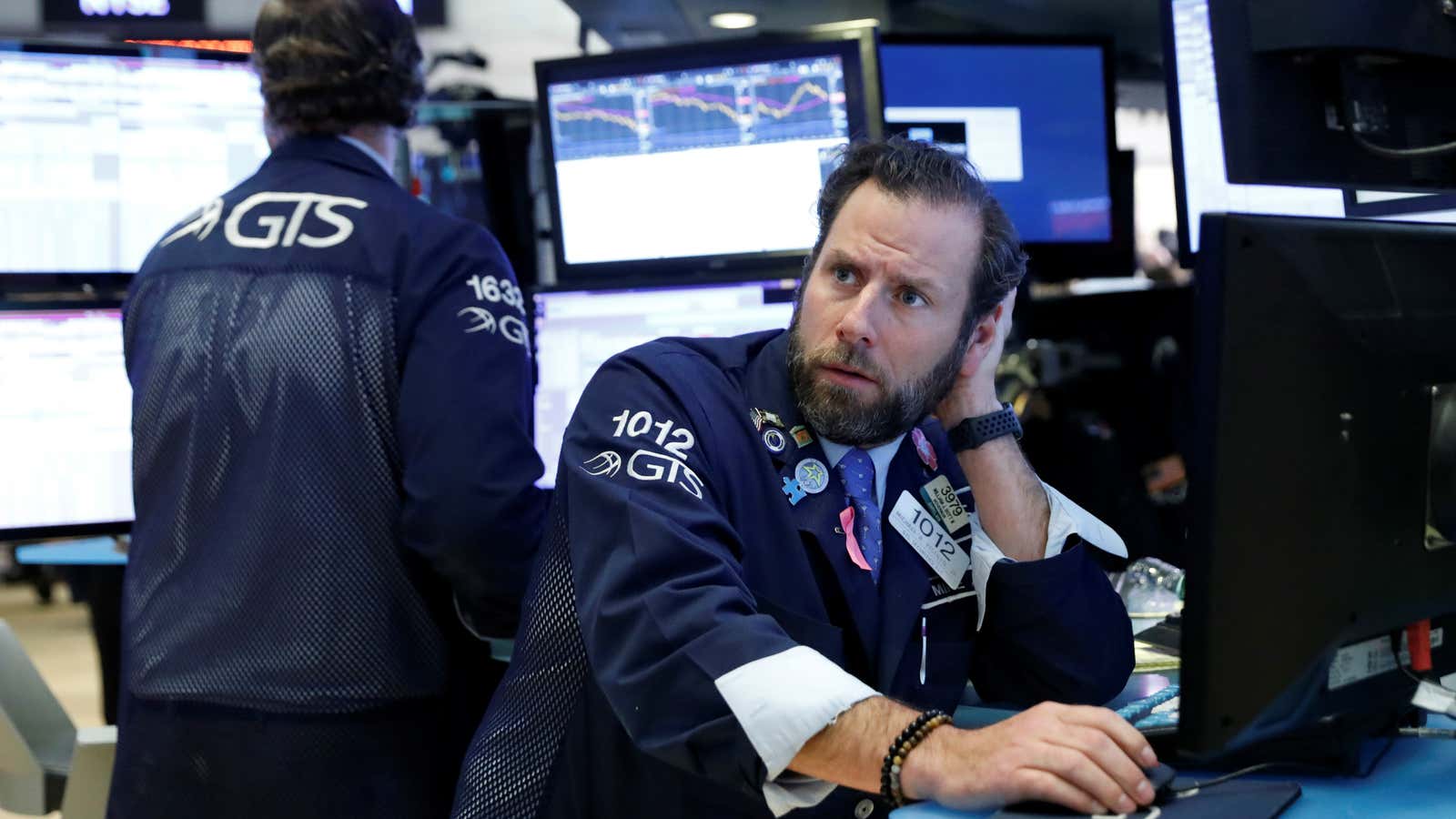Finally, it’s here. The bad news the financial media has been searching for, doggedly, for the last six months. As stocks plunge across the planet, fears of a recession are resurfacing.
We can say this with some confidence: The stock market panic is overblown. And a US recession is not imminent.
Don’t read too much into the stock market drop
Let’s first look at what we should conclude from the markets’ big nosedive—and what it tells us about the real economy.
Stock prices supposedly reflect the future value of corporate profits, after taxes. Those have been surging pretty steadily for most of the last two years, so it’s no wonder stock valuations have been frothy. Booming corporate profits might tell you that consumer demand is healthy—and, therefore, so is the overall economy. Or they might tell you that the Trump administration recently gave them a massive tax cut. Or, more probably, both.
What higher stock values don’t tell you is much about how households—the engine of the US economy—are doing. In fact, if high corporate profits are in part due to companies keeping the lid on wage growth—as currently seems to be the case—it might show the opposite.
Bull markets are, of course, good for shareholders. But less than half of US households own a single stock at all, according to research by Edward Wolff, an economist at New York University. And the richest 10% of households owns 84% of the value of the stock market. It’s a cliche, but it’s kind mostly true: the fortunes of Wall Street have little in common with those on Main Street.
So what does it say about the US economy when stocks bomb (slightly), like they did over the last couple days? Not much.
It is true that stock markets aggregate stupendous amounts of information that they spit out in the form of prices. So prices drop because investors learned something that spooked them.
But it’s not at all clear what, exactly, that new information might be. Media reports seem to have settled on some combination of the recent rise in yields on 10-year Treasury bonds and hints last week from Federal Reserve chairman Jerome Powell that more monetary tightening–raising of short-term interest rates—might be coming due to stronger growth.
Got that last part—stronger growth?
A healthy US economy
Glibness aside, American growth is indeed strong. Last quarter, the US economy expanded a whopping 4.2%, in real annualized terms. Unemployment is at 48-year lows. Inflation is in check. Consumer confidence is strong. Wages are rising (if only grudgingly). Investment could be better, for sure. But the fact of the matter is, overall, things are looking pretty good right now.
And when the next recession does hit, chances are good that economic conditions will already feel quite different from the present moment.
Remember, the conventional definition of a recession is when the economy shrinks for, at a minimum, two straight quarters. The last one lasted quite a bit longer—from December 2007 to June 2009, making it the longest since the Great Depression. So technically speaking, the US economy would have to have already suffered one quarter of contraction for a recession to be upon us.
Signs will likely be flashing well before that. For instance, the collapse of the housing bubble, which caused the last recession was very clearly underway a year or so before the downturn hit. (Though to be fair, Trump’s penchant for unpredictability probably does up the chances of an unexpected disruption.)
What bond yield curves tell us
But wait—what about the dreaded yield-curve inversion that people have been concerned about recently?
For the past 60 years, whenever the yield curve has inverted—that’s when rates on long-term bonds fall below those of short-term bonds—a recession has hit within two years, according to a recent paper by the Federal Reserve Bank of San Francisco (pdf).
Why does this happen? To name a couple possibilities, it could be that investors expect the Fed to lower rates—which it would do in response to a recession. Or maybe it’s because investors are less worried about long-term risks.
The yield curve hasn’t yet inverted. In late summer, it was nosing down dangerously close to it. Then, in the last month or so, long-term rates have started pepping right up again. So that warning sign has faded for now.
This widespread fear of falling long-term interest rates is kind of funny given that the stock market selloff this week was supposedly triggered by fears that long-term rates were rising too fast, as Patrick Chovanec, economist at Silvercrest Asset Management, notes wryly. He also points out that rates are inching higher because investors expect even more robust growth—not because they fear an inflationary flare-up. “Given where growth and inflation are right now, I’d rather see longer-term interest rates rise with shorter-term rate hikes than FAIL to rise with them,” he adds.
That doesn’t mean a recession won’t eventually hit. It most certainly will—followed by another, and another, and another after that. But not right this second. And it’s probably not going to be sneaking up on anybody.
